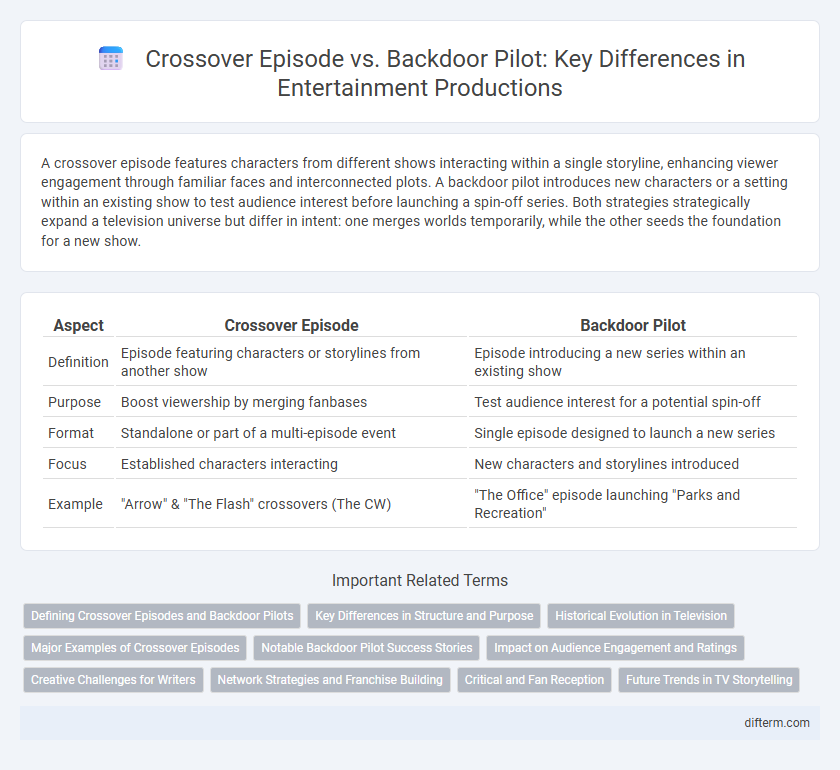A crossover episode features characters from different shows interacting within a single storyline, enhancing viewer engagement through familiar faces and interconnected plots. A backdoor pilot introduces new characters or a setting within an existing show to test audience interest before launching a spin-off series. Both strategies strategically expand a television universe but differ in intent: one merges worlds temporarily, while the other seeds the foundation for a new show.
Table of Comparison
| Aspect | Crossover Episode | Backdoor Pilot |
|---|---|---|
| Definition | Episode featuring characters or storylines from another show | Episode introducing a new series within an existing show |
| Purpose | Boost viewership by merging fanbases | Test audience interest for a potential spin-off |
| Format | Standalone or part of a multi-episode event | Single episode designed to launch a new series |
| Focus | Established characters interacting | New characters and storylines introduced |
| Example | "Arrow" & "The Flash" crossovers (The CW) | "The Office" episode launching "Parks and Recreation" |
Defining Crossover Episodes and Backdoor Pilots
Crossover episodes unite characters and storylines from two or more established TV shows, creating a shared universe that boosts viewer engagement and expands narrative possibilities. Backdoor pilots serve as introductory segments within an existing series, designed to test audience interest and viability for a potential spin-off show without committing to a standalone pilot episode. Both formats strategically leverage existing fan bases to enhance expansion but differ in their primary purpose--crossovers emphasize collaboration, while backdoor pilots focus on launching new series.
Key Differences in Structure and Purpose
A crossover episode merges characters or storylines from two separate shows within a shared universe to enhance viewer engagement and expand narrative depth. A backdoor pilot introduces new characters or settings within an existing series to test audience interest and serve as a launchpad for a potential spin-off. The key difference lies in crossovers reinforcing established worlds, while backdoor pilots aim to create distinct new series.
Historical Evolution in Television
Crossover episodes emerged in the 1970s as a strategy to boost viewership by linking narratives of popular TV series, exemplified by the iconic "The Brady Bunch/Partridge Family Hour." Backdoor pilots gained prominence in the 1980s and 1990s, notably with "The Office" using an episode to test the potential of a spin-off series. The evolution reflects television's adaptive storytelling techniques to expand universes and engage audiences while minimizing production risks.
Major Examples of Crossover Episodes
Major examples of crossover episodes include the "Arrowverse" series where shows like Arrow, The Flash, and Supergirl intertwine storylines, enhancing viewer engagement through shared characters and plots. Another notable crossover is the "Chicago" franchise by Dick Wolf, featuring Chicago Fire, Chicago P.D., and Chicago Med, which frequently blend narratives to create a cohesive universe. These crossovers drive higher ratings and deepen audience investment by merging distinct series into a broader, interconnected entertainment experience.
Notable Backdoor Pilot Success Stories
Notable backdoor pilot success stories include "The Jeffersons," which originated from an episode of "All in the Family," and "NCIS," which was introduced through episodes of "JAG." These backdoor pilots effectively tested audience interest before launching standalone series, ensuring higher chances of success. This strategy contrasts with crossover episodes that primarily aim to boost viewership by merging characters or storylines temporarily.
Impact on Audience Engagement and Ratings
Crossover episodes enhance audience engagement by merging fanbases from different shows, often resulting in higher ratings due to increased viewership and shared storylines that create buzz across platforms. Backdoor pilots introduce new characters or settings within an existing series, sparking curiosity and testing audience interest before committing to a full series, which can lead to a more targeted and invested viewership. Both strategies influence ratings, but crossovers typically drive immediate spikes in audience numbers, while backdoor pilots aim for long-term engagement by nurturing anticipation for new content.
Creative Challenges for Writers
Writers face unique creative challenges when developing crossover episodes, as they must blend distinct characters and storylines while maintaining continuity across multiple shows. In contrast, backdoor pilots demand crafting a self-contained narrative that introduces new characters and settings without alienating the existing audience. Balancing character development and plot coherence remains critical in both formats to ensure seamless storytelling and viewer engagement.
Network Strategies and Franchise Building
Crossover episodes leverage established characters across multiple shows to boost viewership and create interconnected storylines, enhancing network programming synergy and audience retention. Backdoor pilots function as embedded episodes within existing series, serving as low-risk tests to gauge audience interest in potential spin-offs, facilitating strategic franchise expansion. Networks employ these tactics to capitalize on brand loyalty, optimize marketing efforts, and build sustainable entertainment franchises with diversified revenue streams.
Critical and Fan Reception
Crossover episodes often receive positive critical acclaim and fan enthusiasm for blending beloved characters and expanding narrative universes, enhancing viewer engagement across multiple series. Backdoor pilots tend to evoke mixed responses, as fans may be intrigued by new story potential but wary of disrupting established show dynamics or diverting focus. Ratings and social media reactions frequently highlight a preference for crossovers due to their seamless integration and celebration of familiar franchises.
Future Trends in TV Storytelling
Crossover episodes and backdoor pilots increasingly shape future trends in TV storytelling by expanding narrative universes and engaging diverse fanbases within a single franchise. Crossover episodes boost viewer retention through interconnected plots across multiple shows, while backdoor pilots test spin-off potential without disrupting main series continuity. Emerging trends emphasize immersive, multi-platform storytelling that leverages these strategies to create cohesive, expansive entertainment ecosystems.
crossover episode vs backdoor pilot Infographic

 difterm.com
difterm.com